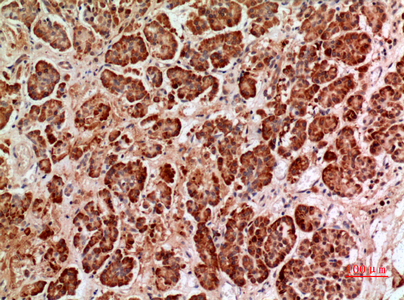HPA1 Polyclonal Antibody
- Catalog No.:YT5353
- Applications:WB;IHC;IF;ELISA
- Reactivity:Human;Rat;Mouse;
- Target:
- HPA1
- Fields:
- >>Glycosaminoglycan degradation;>>Metabolic pathways;>>Proteoglycans in cancer
- Gene Name:
- HPSE
- Protein Name:
- Heparanase
- Human Gene Id:
- 10855
- Human Swiss Prot No:
- Q9Y251
- Mouse Swiss Prot No:
- Q6YGZ1
- Immunogen:
- The antiserum was produced against synthesized peptide derived from the Internal region of human HPSE. AA range:241-290
- Specificity:
- HPA1 Polyclonal Antibody detects endogenous levels of HPA1 protein.
- Formulation:
- Liquid in PBS containing 50% glycerol, 0.5% BSA and 0.02% sodium azide.
- Source:
- Polyclonal, Rabbit,IgG
- Dilution:
- WB 1:500 - 1:2000. IHC: 1:100-1:300. ELISA: 1:20000.. IF 1:50-200
- Purification:
- The antibody was affinity-purified from rabbit antiserum by affinity-chromatography using epitope-specific immunogen.
- Concentration:
- 1 mg/ml
- Storage Stability:
- -15°C to -25°C/1 year(Do not lower than -25°C)
- Other Name:
- HPSE;HEP;HPA;HPA1;HPR1;HPSE1;HSE1;Heparanase;Endo-glucoronidase;Heparanase-1;Hpa1
- Observed Band(KD):
- 62kD
- Background:
- Heparan sulfate proteoglycans are major components of the basement membrane and extracellular matrix. The protein encoded by this gene is an enzyme that cleaves heparan sulfate proteoglycans to permit cell movement through remodeling of the extracellular matrix. In addition, this cleavage can release bioactive molecules from the extracellular matrix. Several transcript variants encoding different isoforms have been found for this gene. [provided by RefSeq, Sep 2011],
- Function:
- enzyme regulation:Inhibited by EDTA, laminarin sulfate and, to a lower extent, by heparin and sulfamin and activated by calcium and magnesium.,function:Endoglycosidase which is a cell surface and extracellular matrix-degrading enzyme. Cleaves heparan sulfate proteoglycans (HSPGs) into heparan sulfate side chains and core proteoglycans. Also implicated in the extravasation of leukocytes and tumor cell lines. Due to its contribution to metastasis and angiogenesis, it is considered to be a potential target for anti-cancer therapies.,PTM:N-glycosylated. Glycosylation of the 50 kDa subunit appears to be essential for its solubility.,PTM:Proteolytically processed. The cleavage of the 65 kDa form leads to the generation of a linker peptide, 8 kDa and 50 kDa product. The active form, the 8/50 kDa heterodimer, is resistant to degradation. Complete removal of the linker peptide appears to be a pre
- Subcellular Location:
- Lysosome membrane; Peripheral membrane protein. Secreted. Nucleus. Proheparanase is secreted via vesicles of the Golgi. Interacts with cell membrane heparan sulfate proteoglycans (HSPGs). Endocytosed and accumulates in endosomes. Transferred to lysosomes where it is proteolytically cleaved to produce the active enzyme. Under certain stimuli, transferred to the cell surface. Associates with lipid rafts. Colocalizes with SDC1 in endosomal/lysosomal vesicles. Accumulates in perinuclear lysosomal vesicles. Heparin retains proheparanase in the extracellular medium (By similarity). .
- Expression:
- Highly expressed in placenta and spleen and weakly expressed in lymph node, thymus, peripheral blood leukocytes, bone marrow, endothelial cells, fetal liver and tumor tissues. Also expressed in hair follicles, specifically in both Henle's and Huxley's layers of inner the root sheath (IRS) at anagen phase.
- June 19-2018
- WESTERN IMMUNOBLOTTING PROTOCOL
- June 19-2018
- IMMUNOHISTOCHEMISTRY-PARAFFIN PROTOCOL
- June 19-2018
- IMMUNOFLUORESCENCE PROTOCOL
- September 08-2020
- FLOW-CYTOMEYRT-PROTOCOL
- May 20-2022
- Cell-Based ELISA│解您多样本WB检测之困扰
- July 13-2018
- CELL-BASED-ELISA-PROTOCOL-FOR-ACETYL-PROTEIN
- July 13-2018
- CELL-BASED-ELISA-PROTOCOL-FOR-PHOSPHO-PROTEIN
- July 13-2018
- Antibody-FAQs
- Products Images

- Western Blot analysis of K562 cells using HPA1 Polyclonal Antibody. Secondary antibody(catalog#:RS0002) was diluted at 1:20000

- Immunohistochemical analysis of paraffin-embedded human-pancreas, antibody was diluted at 1:100

- Western blot analysis of lysate from K562 cells, using HPSE Antibody.



